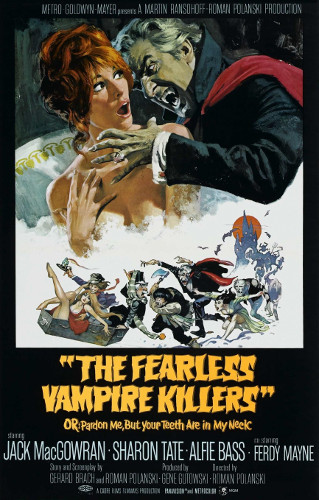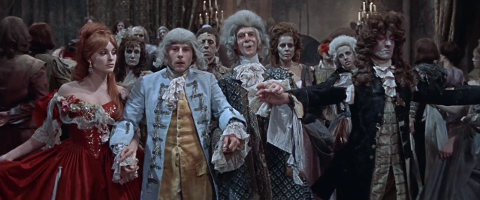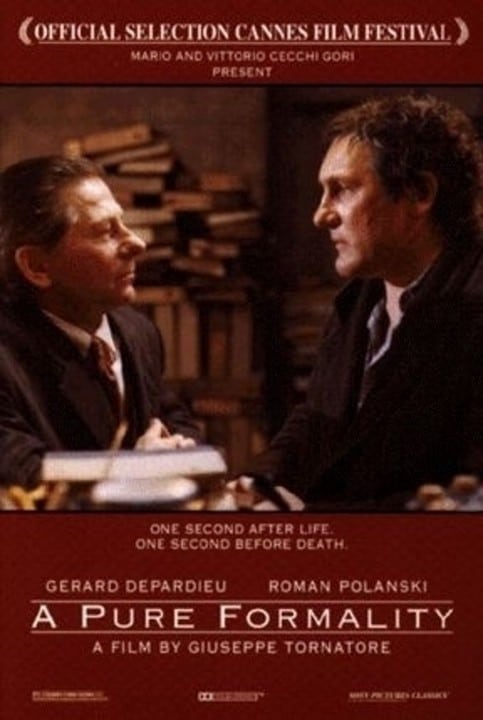The Fearless Vampire Killers (1967)
Directed by: Roman Polanski
Written by: Gérard Brach, Roman Polanski
Starring: Alfie Bass, Ferdy Mayne, Jack MacGowran, Roman Polanski
UK/US
RUNNING TIME: 107 mins/ 91 mins
AVAILABLE ON BLU-RAY [REGION ‘A’ ONLY], DVD and DIGITAL
REVIEWED BY: Dr Lenera
SPOILERS!

Transylvania, in the mid-19th century. The elderly, almost withering Professor Abronsius, formerly of the University of Königsberg, and his shy, bumbling apprentice Alfred are on the hunt for vampires. They arrive at a small village and stay at a local inn full of angst-ridden folk who perform strange rituals to fend off an unseen evil. Alfred develops a fondness for Sarah, the overprotected daughter of the tavern keeper Yoine Shagal, but she’s kidnapped by the local vampire lord Count Von Krolock who also vampirises Shagal. Abronsius and Alfred follow Shagal’s trail in the snow to Krolock’s castle….

I’ve thought for a while that we don’t have enough Roman Polanski on Horror Cult Films, so I’m going to hopefully rectify that with reviews of three of his films, each from a different decade. Firstly we have this erratic comedy horror which I can never quite decide how I feel about. It has some good ideas, some great images and individual scenes which have a real impact and showcase Polanski’s skill as a filmmaker. The money is often up there on the screen. Yet one can argue that Hammer, who were obviously the main inspiration, achieved more with far less, while the previous year’s Carry On Screaming offered more chuckles. Here, not enough of the laughs come off – granted, I probably enjoy the sight of people tripping over, bumping into things, and generally acting like idiots more than some, but after a while it seems more like padding than anything else, the 107 minute film taking ages to get through a plot that Hammer would have had done and dusted in seventy minutes and still had time for a bit more to happen. Yet we can see that Polanski’s world view is already fully formed, good not actually being much effective against evil in the end, especially when, as we see here, good is plagued by misunderstanding and incompetence. Seen with this in mind, the final scene, which initially seemed like a cheap joke to this then-teenager who was used to Hammer’s good vanquishing evil, is actually perfect, the final ironic twist to a story where the good guys have been abject failures – though at least one of the main characters finally gets the girl he’s been in love with – or should that be she gets him?!
This was the last of three films Polanski made in the UK, following Cul-De-Sac and Repulsion, based on original scripts written by himself and frequent collaborator Gérard Brach. Repulsion had done so well that Polanski was given his first large budget. Outdoor filming saw a last minute switch from Austria to Urtijëi in the Dolomites, which meant that location shooting had to be very rushed. There was also friction between the film crew and the Italian technicians who were wrangling more money out of the producers than they should have had, though this was only discovered after cast and crew had gone back in London for studio work. Polanski also decided to switch formats to Panavision while filming on location. Flat scenes already filmed were optically converted to match, resulting in a few odd compositions and instances of stretching. Polanski’s first cut ran a surely overlong 148 minutes; MGM, who would distribute the film in the USA, the UK, Sweden, France and the Netherlands, got producer Martin Ransohoff to cut it down to 107 minutes, and changed the title from The Fearless Vampire Killers to Dance Of The Vampires. The American version was cut even further by MGM Supervising Editor Margaret Booth, down to 91 minutes, removing two scenes with Shagal and Alfred’s first search for the mysterious voice in the castle corridors, as well as greatly shortening the trip to Von Krolock’s castle. A cartoon prologue featuring Abronsius and Alfred was added and everyone re-dubbed with American accents. Polanski unsuccessfully tried to have his name removed from the credits of this version. In the UK, they went for an ‘A’ [equivalent to ‘PG’ rating], so Von Krolock attacking Sarah in her bath was almost completely removed.
The opening titles are neat; after the MGM lion becomes a gargoyle-like vampire face, a drop of animated blood drips from its mouth and falls down the screen as the credits scroll in the opposite direction. We then cut to a close-up of the moon before we pan out from it to reveal a matte painting of a snowy landscape which dissolves to the real thing. A narrator, whose identity will later become apparent, introduces us to our two ‘heroes’ traveling in their carriage through Transylvania, Alfred fending off wolves while Abronsius is frozen solid. An arrival at an inn sorts him out, the camera cutting to various faces suggesting daft things to revive him and somebody even rubbing snow on his ears [yeah that’ll work] before we cut to him with his feet in warm water. The punters at the inn lie or talk nonsense and shut up except for the village idiot who begins to answer a question from Ambronsius, which is one of several jokes that only really work after you’ve thought about them for a bit. The first major ‘comic’ set piece uses the ancient premise of a man being caught with another woman by his wife. Innkeeper Shagal quietly gets out of the bed he shares with his wife Rebecca to go and visit Magda the maid, then has to hide when Rebecca comes calling. However, Rebecca ends up bonking Abronsius over the head with a sausage instead of her naughty husband. Alfie Bass manages to amuse as Shagal mostly by acting as goofily as possible, and seeming no different as a vampire than he is as a human. No doubt PC types would consider the character an ‘offensive stereotype’ today. He’s bitten when Von Krolock kidnaps his daughter Sarah after biting her in one of the more frightening vampire scenes of the period as Krolock jumps through a window down into where Sarah is bathing and attacks her; it’s not erotic but a savage assault. Unfortunately the scene gives the impression that there will be scenes of a similar nature, which there aren’t.

Seeing as Alfred is besotted with Sarah and Ambronsius is happy that vampires really do exist despite the harm that they’re causing, the two pursue Shagal to the local castle. And it’s here where the film really slumps as our intrepid duo are coolly but politely received by Von Krolock and spend a hell of a lot of time wandering and climbing all over the castle, bickering, falling over and Ambronsius even getting stuck. When we have, for example, Alfred accidentally driving a stake into a barrel of wine and then fainting when he has to stake an actual vampire, one starts to yawn. Of course humour is very subjective and I did chuckle a few times, such as when Shagal isn’t allowed to sleep with the family and Koukoll the hunchback servant places his coffin by a window, and when Alfred flees a vampire but doesn’t realise that he’s running in a circle that brings him right back round to his pursuer; it benefits from us seeing it coming. The main reason the gag of a cross not working on a Jewish vampire doesn’t make us laugh much is that it’s been frequently imitated since. We also get the screen’s first male gay vampire in Von Krolock’s son Herbert who looks like David Peel’s Baron Meinster from The Brides Of Dracula; he takes a shine to Alfred and it’s only a bit played for laughs. Ferdy Mayne has real magnetism and authority as the Dracula substitute. He’d later play the real deal in another comedic toothfest, The Vampire Happening. A vampire ball is probably inspired by the one in The Kiss Of The Vampire but is far more elaborate and these vampires are mostly ugly; there’s a real sense of decay and decadence. Indeed there seems to be little that’s sexy about these vampires, while Ambronsius also seems to be wasting away, though he’s suddenly able to run in the climactic chase, a sequence that fails to ramp up the fear and the excitement the way that it should.
Abronsius and Alfred muddle through until near the end where they finally seem to have achieved some level of competence. Abronsius even pretends to be God, shouting down a chimney flue at Shagal to leave Magda alone, and it works. However, it’s too late to alter the direction that things are going in. One crucial moment of vampirising is shown at a distance with Abronsius and Alfred having to watch and not be able to do anything about it. They’re helpless in the face of this evil. The Fearless Vampire Killers seems more downbeat and even nihilistic with each viewing. Krolock talks about “the natural order of things” from the point of view of an aristocrat who is basically out to harvest the poor, not just explicitly stating the class subtext of many vampire films but suggesting that this is how things are and should always be. Abronsius may seem like a kindly old man, but he actually manipulates and pressurises Alfred throughout. Alfred’s main goal of course becomes to rescue the girl he’s fallen for. He only interacts with Sarah three times and two of them are through a window, but nonetheless one can’t shake off a feeling of real-life tragedy because Polanski also fell for the actress playing Sarah during filming, Sharon Tate, and married her, only for her to become one of the victims of the Manson Murders, a beautiful starlet in the prime of life. When Alfred is desperately searching for her in the castle and needs to find her before she’s vampirised, our knowledge of those true events do cast a darker spell over the proceedings that we want. But then the ending is as bitter as they come anyway. Two people, one of them out to destroy a group of vampires, end up inadvertently becoming the means by which the plague of vampirism spreads out of Transylvania and into the world.
There’s a creepy shot that has us looking down onto a graveyard and the graves beginning to open up with vampires creeping out of them, but Polanski, who showed an adeptness at and a willingness to frighten elsewhere, seems to be holding back with the horror. I guess he wanted audiences to be laughing more than than being frightened, but few seemed to do that upon release, though the film’s reputation has grown. And despite its longuers, there’s some evidence of the cutting down. Abronsius seems to have some character inconsistencies where it looks like explanatory material is missing, while we don’t learn why Magda is so petrified of Koukoll; yes I know he’s ugly but it seems like it should be more than that. But Polanski and Jack MacGowran make for a fun team even if the material they have to work with doesn’t always seem worthy of them. MacGowran throws himself into his role with some amusing physical eccentricities, though it’s hard to understand what he’s saying at times. Polanski rarely speaks for the first half and to be honest seems ill at ease in his first starring role in front of the camera, though this sort of works for the part. The castle doesn’t look too impressive from a distance the first time we see it, but the interiors are magnificent and the artifice of some of the snow scapes around the building add a fairy-tale ambience, though in general this goes for a more realistic approach than Hammer did or could afford to do, with far more actual location work; for a while, the only real location Christopher Lee’s Dracula seemed to ever travel to was Black Park just outside Slough. Krzystof Komeda’s music score is often darkly beautiful with its strange chorale effects, avoiding cliche yet still managing to chill. It sometimes sounds like we’re listening to Philip Glass. Judging by the high standard of so much of Polanski’s work, The Fearless Vampire Killers is a misfire, yet it has some very good stuff in it, and you can still tell it was made by a very good filmmaker. It’s just that he was having a bit of an off day.







Be the first to comment